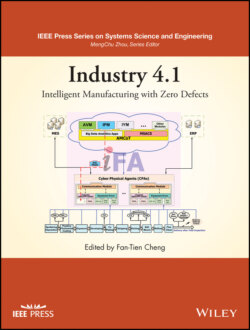Читать книгу Industry 4.1 - Группа авторов - Страница 21
1.2.1.2 Supply Chain (SC)
ОглавлениеThe SC is defined as a network of facilities and distribution designed to perform tasks, such as procuring materials, transforming materials into intermediate and finished products, and distributing the finished products to customers [6]. The objective of the SC is to deliver the correct quantity of the right product at the right time at minimum cost. The SC is designed to achieve timely and economical delivery of products required by the O2D cycle [7], and to support the collaborative computing of distributed orders in the semiconductor industry to ensure coherent IC manufacturing operations.
Figure 1.6 presents the architecture of an electronic supply chain management (ESCM) and its key processes [18]. This ESCM has been deployed in Taiwan Semiconductor Manufacturing Company (tsmc) [19]. The ESCM architecture comprises demand‐planning, allocation‐planning, capacity‐modeling, allocation‐management, order‐management, available‐to‐promise (ATP), and output‐planning mechanisms. The demand‐forecast process and purchase‐order process of ESCM are presented in the following paragraphs.
Demand‐Forecast Process
Figure 1.6 ESCM architecture and key processes.
Source: Reprinted with permission from Ref. [14]; © 2010 IEEE.
The demand‐planning mechanism receives demand forecasts from a customer. The demand forecast specifies forecasted production of a process technology required by the customer in a predetermined period. Then, the demand forecast is adjusted by the demand‐planning mechanism. The adjusted demand forecast is sent to an allocation‐planning mechanism, which determines a capacity‐allocated‐support demand (CASD) based on the adjusted demand forecast and the capacity plan. Next, the CASD is forwarded to the allocation‐management mechanism for support commitment is generated accordingly. Finally, the support commitment is sent to the customer.
Purchase‐Order Process
When a purchase order (PO) is placed by a customer, the PO is received and forwarded to the ATP mechanism by the order‐management mechanism. After receiving the information pertaining to the PO, the ATP mechanism determines the amount of CASD to be booked and the ATP production to be consumed. Next, the ATP mechanism sends the information pertaining to the booked CASD to the allocation‐management mechanism. Once the booked CASD is received, the allocation‐management mechanism adjusts the initial CASD accordingly. Meanwhile, the ATP mechanism also sends information pertaining to the consumed ATP production to the output‐planning mechanism. With the consumed ATP production received from the ATP mechanism and the capacity plan from the capacity‐modeling mechanism, the output‐planning mechanism can generate a master production schedule (MPS) accordingly, which is sent to the manufacturing planning subsystem for shipping the product to the customer.
Cheng et al. [8] have also developed a holonic supply‐chain system (HSCS) as shown in Figure 1.7. The HSCS consists of several communication holons. Each company in the SC should possess a communication holon. The HSCS employs distributed object and mobile object technologies, RosettaNet implementation framework, and holon and holarchy concepts. The systematic approach applied to develop the HMES is also utilized in constructing the HSCS. The GH is first developed. Next, the communication holon is generated by inheriting the GH. As shown in Figure 1.7, each company in the SC, such as Company I, requires a communication holon as the communication component for correspondence with other companies in the SC. The communication holon exhibits basic holonic attributes, such as intelligence, autonomy, and cooperation. Furthermore, the communication holon can handle partner interface processes and data exchange of various data formats by following the standards of RosettaNet business messages. As a result, the HSCS can meet the future requirements of the SC information integration of virtual enterprises [8].
Figure 1.7 Functional‐block diagram of the holonic supply‐chain system.
Source: Reprinted with permission from Ref. [14]; © 2010 IEEE.
